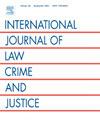How much is the crime prevention programme for fraud worth? On the cost benefit analysis in the case of police with unsolved cases remaining
IF 1.4
4区 社会学
Q3 CRIMINOLOGY & PENOLOGY
International Journal of Law Crime and Justice
Pub Date : 2025-03-19
DOI:10.1016/j.ijlcj.2025.100744
引用次数: 0
Abstract
This paper attempts to estimate the monetary value of preventive policing programmes that are being adopted by police forces around the world in response to growing concerns about economic crime. To do this, we reviewed existing studies on the cost of crime and cost-benefit analysis, set the standard for calculating the economic indicators using highly reliable data, and derived two indicators to measure the value of preventive policing against economic crime: the reduction in direct financial loss and the conditional reduction in criminal justice costs from reduced police officer workload. As a policing case to apply the indicators, we selected the National Counter Scam Centre's (NCSC) technology-based prevention and advice policy in the Korean police. By comparing two sets of data, we found that the victimisation rate of citizens who benefited from the policy was 1 %, which is 2.35 % lower than the victimisation rate of the general population of 3.35 %. Based on this, it is estimated that if 1239 (December 2023 average) preventative counselling sessions were provided every day for one year (249 working days), a total of around £101.4 million in direct harm would be prevented. However, in the case of criminal justice cost savings, we found that the remaining unsolved case problems in the target society would require police officers to work at full capacity, even with the preventive policing programme, which leads to no change in workload-based cost savings. As a result, this study found that the benefits of preventive policing are 58 times greater than the costs, while presenting new standards in criminal justice cost saving estimation, the issue of unsolved cases when estimating cost savings from workload changes in policing. However, the short timeframe of this study's methods (pre- and post-intervention) has the limitation in terms of its evidential robustness.
预防欺诈犯罪计划价值几何?关于尚未破案的警方的成本效益分析
本文试图估计预防性警务方案的货币价值,世界各地的警察部队正在采用这些方案,以应对对经济犯罪日益增长的关切。为此,我们回顾了有关犯罪成本和成本效益分析的现有研究,使用高度可靠的数据制定了计算经济指标的标准,并推导出两个指标来衡量预防性警务对经济犯罪的价值:减少直接经济损失和减少警务人员工作量有条件地减少刑事司法成本。作为应用这些指标的警务案例,我们选择了韩国警方国家反诈骗中心(NCSC)基于技术的预防和建议政策。通过对比两组数据,我们发现受益于该政策的公民受害率为1%,比普通人群的受害率(3.35%)低2.35%。基于此,据估计,如果在一年(249个工作日)内每天提供1239次(平均2023年12月)预防性咨询,将防止总计约1.014亿英镑的直接伤害。然而,在节省刑事司法成本的情况下,我们发现目标社会中尚未解决的案件问题需要警务人员满负荷工作,即使有预防性警务计划,这导致基于工作量的成本节约没有变化。因此,本研究发现预防性警务的收益是成本的58倍,同时提出了刑事司法成本节约估算的新标准,在估算警务工作量变化带来的成本节约时,未解决案件的问题。然而,本研究方法的短时间框架(干预前和干预后)在其证据稳健性方面存在局限性。
本文章由计算机程序翻译,如有差异,请以英文原文为准。
求助全文
约1分钟内获得全文
求助全文
来源期刊
CiteScore
2.70
自引率
0.00%
发文量
25
审稿时长
47 days
期刊介绍:
The International Journal of Law, Crime and Justice is an international and fully peer reviewed journal which welcomes high quality, theoretically informed papers on a wide range of fields linked to criminological research and analysis. It invites submissions relating to: Studies of crime and interpretations of forms and dimensions of criminality; Analyses of criminological debates and contested theoretical frameworks of criminological analysis; Research and analysis of criminal justice and penal policy and practices; Research and analysis of policing policies and policing forms and practices. We particularly welcome submissions relating to more recent and emerging areas of criminological enquiry including cyber-enabled crime, fraud-related crime, terrorism and hate crime.

 求助内容:
求助内容: 应助结果提醒方式:
应助结果提醒方式:


